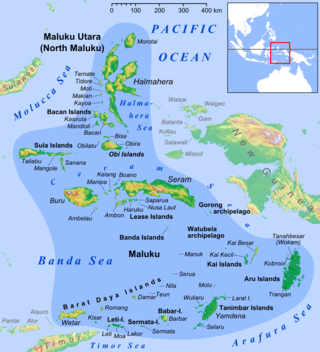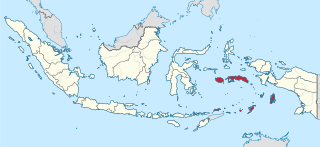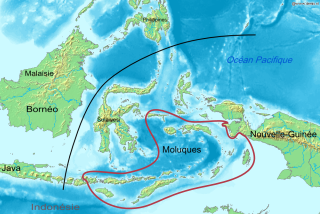Related Research Articles

The Maluku Islands or the Moluccas are an archipelago in the eastern part of Indonesia. Tectonically they are located on the Halmahera Plate within the Molucca Sea Collision Zone. Geographically they are located east of Sulawesi, west of New Guinea, and north and east of Timor. Lying within Wallacea, the Moluccas have been considered a geographical and cultural intersection of Asia and Oceania.
Maluku may refer to:

Maluku is a province of Indonesia. It comprises the central and southern regions of the Maluku Islands. The largest city and capital of Maluku province is Ambon on the small Ambon Island. It is directly adjacent to North Maluku, Southwest Papua, and West Papua in the north, Central Sulawesi, and Southeast Sulawesi in the west, Banda Sea, Australia, East Timor and East Nusa Tenggara in the south and Arafura Sea, Central Papua and South Papua in the east. The land area is 57803.81 km2, and the total population of this province at the 2010 census was 1,533,506 people, rising to 1,848,923 at the 2020 census, the official estimate as at mid 2023 was 1,908,753. Maluku is located in Eastern Indonesia.
Roma or Romang is a Malayo-Polynesian language spoken by about 1,700 people in Jersusu village on Romang island in Maluku, Indonesia.
The Sawai language is a South Halmahera language of the Austronesian language family spoken in the Weda and Gane Timor districts of southern Halmahera, northern Maluku Province, Indonesia. There are approximately 12,000 speakers.

The Central Malayo-Polynesian languages (CMP) are a proposed branch in the Malayo-Polynesian subgroup of the Austronesian language family. The languages are spoken in the Lesser Sunda and Maluku Islands of the Banda Sea, in an area corresponding closely to the Indonesian provinces of East Nusa Tenggara and Maluku and the nation of East Timor, but with the Bima language extending to the eastern half of Sumbawa Island in the province of West Nusa Tenggara and the Sula languages of the Sula archipelago in the southwest corner of the province of North Maluku. The principal islands in this region are Sumbawa, Sumba, Flores, Timor, Buru, and Seram. The numerically most important languages are Bima, Manggarai of western Flores, Uab Meto of West Timor, and Tetum, the national language of East Timor.
The Central Maluku languages are a proposed subgroup of the Central–Eastern Malayo-Polynesian branch of the Austronesian language family which comprises around fifty languages spoken principally on the Seram, Buru, Ambon, Kei, and the Sula Islands. None of the languages have as many as fifty thousand speakers, and several are extinct.
The Babar languages are a subgroup of the Austronesian language family spoken on the Babar Islands.
The Timoric languages are a group of Austronesian languages spoken on the islands of Timor, neighboring Wetar, and Southwest Maluku to the east.
Kei is an Austronesian language spoken in a small region of the Moluccas, a province of Indonesia.
Kayeli is an extinct Austronesian language once used by the Kayeli people of the Indonesian island Buru. Two dialects were recognized, namely Leliali (Liliali) and Lumaete.
Lisela, also called Li Enyorot, is an Austronesian language; in 1989 it was spoken by about 11,900 Lisela people mostly living in the northern part of Indonesian island Buru. It is also preserved among the small Lisela community on the Ambon Island.
Teun is an Austronesian language originally spoken on Teun Island and Nila Island in Maluku, Indonesia. Speakers were relocated to Seram due to volcanic activity on Teun.
Nila is an extinct Austronesian language originally spoken on Nila Island in Maluku, Indonesia. Speakers were relocated to Seram due to volcanic activity on Nila.
Serua is an extinct Austronesian language originally spoken on Serua Island in Maluku, Indonesia. Speakers were relocated to Seram due to volcanic activity on Serua. The language continues in communities in Waipia in Seram, where the islanders were resettled, along with those also from Nila and Teun. Here, the older generation retained the island language as a strong form of identity. It was found to be extinct in 2024.
East Damar is one of two Austronesian languages spoken on Damar Island in Maluku, Indonesia.
Serili is an Austronesian language spoken on Marsela Island in South Maluku, Indonesia.
Imroing is an Austronesian language spoken in a single village on Babar Island in South Maluku, Indonesia.
Telaʼa, or Tela-Masbuar (Masbuar-Tela) is an Austronesian language spoken in the two villages with those names on Babar Island in South Maluku, Indonesia.
Hukumina is an extinct Austronesian language recently spoken in the northwest of Buru Island in the Maluku Islands of eastern Indonesia. It had one native speaker in 1989.
References
- ↑ Emplawas at Ethnologue (18th ed., 2015) (subscription required)
- ↑ Taber, Mark (1993). "Toward a better understanding of the Indigenous Languages of Southwestern Maluku". Oceanic Linguistics. 32 (2): 389–441. doi:10.2307/3623199. JSTOR 3623199.